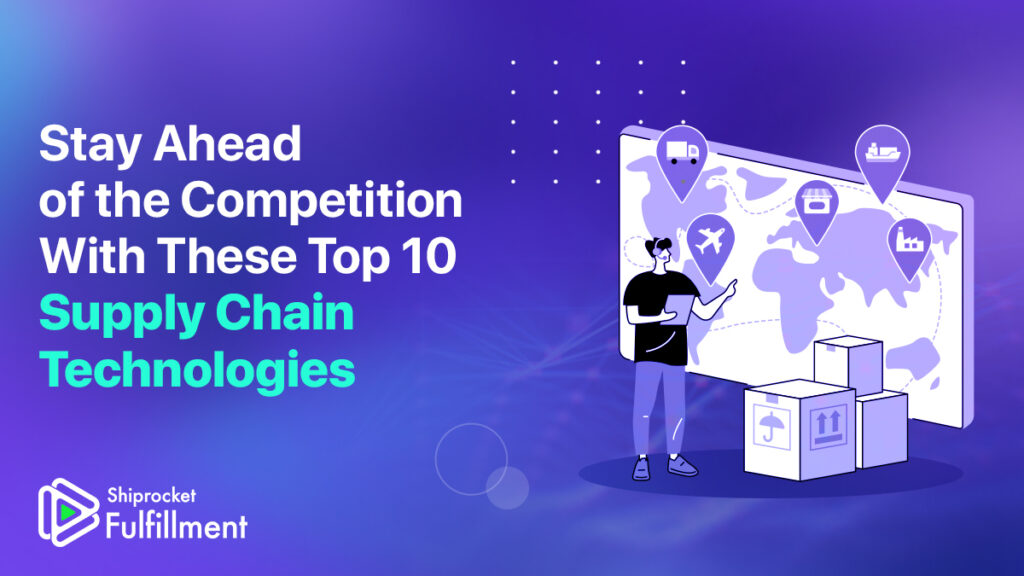In today’s rapidly evolving business landscape, supply chain technologies have emerged as transformative tools that reshape organisations’ operations. From digitisation and automation to advanced analytics and artificial intelligence, these technologies revolutionise business operations’ efficiency, agility, and sustainability. By harnessing the power of these innovations, companies can gain a competitive edge, enhance customer satisfaction, and drive overall growth.

Let’s explore the key supply chain technologies driving this transformation and discusses their impact on modern businesses.
Evolution of Supply Chain Technologies: A Game-Changer for Businesses
The evolution of supply chain technologies has emerged as a game-changer for businesses, revolutionising how organisations operate and respond to customer demands.
The recent global pandemic further emphasised the need for resilient supply chains, prompting organisations to focus on building robust systems capable of withstanding disruptions.
The modern supply chain has transitioned from a functional orientation to a globally interconnected network fueled by cutting-edge technologies like artificial intelligence (AI), blockchain, and automation. These technologies are integrated into the digital supply network, empowering businesses to meet the evolving demands of customers who expect next- and same-day deliveries.
Disruptive technologies such as advanced robotics, autonomous systems, and additive manufacturing are reshaping end-to-end production processes and global supply chain management.
The retail industry, in particular, has been profoundly impacted by digital technology, eCommerce, and hyper-personalisation, resulting in growing supply chain complexity. To adapt, retailers invest in a robust tech foundation to improve operational efficiency and enhance customer experiences.
Supply chain management itself has undergone a significant transformation thanks to technological advancements. Cloud-based solutions, automation, and end-to-end transportation software have streamlined processes, reduced costs, and improved customer service.
Tech trends like ecommerce, automation, and logistics innovations drive the evolution of the supply chain. These trends have led to a shift in consumer expectations, compelling companies to prioritise their supply chains to remain competitive.
Exploring the Top 10 Supply Chain Technologies
Here are the top 10 supply chain technologies transforming business operations:
Augmented and Virtual Reality
Augmented and virtual reality (AR/VR) technologies are revolutionising supply chain operations. With AR/VR, you can visualise and simulate complex processes, improving operational efficiency and reducing errors. By overlaying digital information onto the physical environment, AR enhances warehouse picking accuracy and speeds up training processes. VR enables immersive training experiences, allowing employees to practice handling equipment and navigating virtual warehouses, minimising risks and improving safety.
Artificial Intelligence and Machine Learning
AI and ML empower supply chains with advanced analytics, automation, and intelligent decision-making. By analysing vast amounts of data, AI algorithms optimise demand forecasting, inventory management, and route planning, reducing costs and improving customer satisfaction. ML algorithms continuously learn and adapt, identifying patterns and anomalies to proactively enhance quality control and detect potential disruptions.
Blockchain
It provides a transparent and secure platform for supply chain operations. It enables end-to-end traceability, enhancing visibility and accountability. Blockchain eliminates fraud and counterfeiting risks by recording transactions in a decentralised and immutable ledger. Smart contracts automate and streamline contractual agreements, improving supplier relationships and reducing administrative overhead. Blockchain fosters trust and collaboration among supply chain partners, driving efficiency and ensuring ethical sourcing.
3D Printing
Also known as additive manufacturing, it revolutionises traditional manufacturing processes. It enables on-demand production, reducing lead times and inventory costs. With 3D printing, you can create prototypes, spare parts, and customised products, eliminating the need for extensive warehousing and transportation. It promotes supply chain agility, facilitates rapid response to market demands and reduces reliance on global supply chains.
Cloud Computing
It empowers supply chains with scalability, flexibility, and real-time collaboration. By leveraging cloud-based platforms, companies can store and analyse large volumes of data, enabling data-driven decision-making. Cloud-based supply chain management systems provide real-time visibility across the entire supply network, facilitating seamless coordination and improving response times. It also supports remote work capabilities, enabling geographically dispersed teams to collaborate efficiently.
Big Data and Analytics
Harnessing the power of big data and advanced analytics enables you to gain valuable insights and make data-driven decisions. You can identify patterns, optimise inventory levels, forecast demand more accurately, and enhance operational efficiency. Leveraging big data and analytics empowers you to proactively address challenges, reduce costs, and improve customer satisfaction by ensuring timely deliveries and better supply chain visibility.
The Internet of Things (IoT)
Embracing the IoT revolutionises supply chain management by connecting devices and assets throughout your network. IoT sensors and devices provide real-time visibility into inventory levels, monitor environmental conditions, optimise route planning, and enable predictive maintenance. With enhanced tracking and monitoring capabilities, you can streamline operations, minimise disruptions, and improve product quality, ensuring efficient and reliable supply chain processes.
Robotics and Automation
Integrating robotics and automation technologies into your supply chain operations automates repetitive tasks, increases productivity, and reduces errors. Robots can handle order picking, packing, and sorting, enhancing operational speed and accuracy. Automated systems facilitate warehouse optimisation, inventory management, and order fulfillment. By 2026, 75% of large enterprises will have adopted some form of intralogistics smart robots in their warehouse operations.
5G and Starlink
The advent of 5G and satellite internet connectivity, such as Starlink, revolutionised supply chain communications and enhanced connectivity across geographically dispersed locations. High-speed, low-latency networks enable real-time data transmission, remote monitoring, and seamless collaboration. With reliable and fast communication capabilities, supply chain stakeholders can achieve better coordination, faster response times, and improved decision-making, increasing operational efficiency and customer satisfaction.
Digital Supply Chain Twin and Control Towers
These provide end-to-end visibility and enable centralised monitoring and control of supply chain operations. Creating a digital replica of your supply chain allows you to simulate and optimise processes, identify bottlenecks, and proactively respond to disruptions. Control towers consolidate data from various sources, offering a holistic view of the supply chain and facilitating real-time decision-making. Almost 80% of companies will suffer significant losses if they don’t merge their digital supply chain twin and control tower initiatives by 2026.
How Shiprocket’s Technology-Enabled Supply Chain Can Benefit Your Business
Shiprocket’s technology-enabled supply chain can significantly benefit your business by streamlining your operations and enhancing efficiency. With the integration of digital tools and innovative solutions, Shiprocket offers a range of advantages that can propel your business growth.
Shiprocket’s digital supply chain management empowers you to optimise the various stages of your supply chain cycle, including planning, sourcing, making, delivery, and returns.
Additionally, Shiprocket’s technology-driven approach enhances supply chain resiliency, which is crucial in today’s dynamic business landscape. Shiprocket enables you to mitigate disruptions, predict demand fluctuations, and maintain surplus capacity for raw materials and finished goods.
Shiprocket’s fulfillment capabilities further strengthen your eCommerce business. Its technology ensures speedy order processing, accurate tracking, and seamless last-mile delivery, enhancing customer experience and building brand loyalty.
Moreover, Shiprocket’s global reach and comprehensive shipping solutions benefit international eCommerce businesses. With an extensive pin code reach and robust automation features, Shiprocket simplifies cross-border shipping, enabling you to tap into international markets effortlessly.
Conclusion
The supply chain management landscape is undergoing a profound transformation. Businesses that embrace these technologies and adapt to the changing dynamics of the digital era are well-positioned to thrive in the competitive business environment. You can optimise your supply chains, streamline operations, and deliver superior customer experiences by leveraging digitisation, automation, analytics, and sustainable practices. It’s time for businesses to seize the opportunities presented by these transformative technologies and revolutionise their operations for long-term success.

Frequently Asked Questions(FAQs)
The types of supply chain models are continuous flow, fast chain, efficient chain, agile, custom-configured, and flexible.
The impact of technology on supply chain management is significant as it helps in reducing costs, improving customer service, and increasing operational efficiency.
Supply chain technology enhances visibility and traceability by providing real-time insights into inventory levels, product movements, and order tracking.





